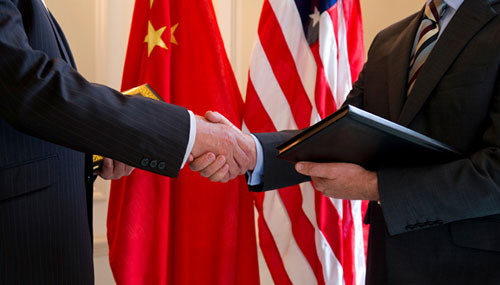U.S.-Asia Business
US-China 2017 Outlook: Opportunity Amidst Volatility

East West Bank Chairman and CEO Dominic Ng says new realities require expert guidance.
It’s a new year, a new administration and a new landscape for U.S.-China economic relations. There are plenty of reasons to buckle up for a bumpy ride: China’s economic growth rate is expected to slow down further, bilateral trade is expected to suffer from a resurgence of trade protectionism globally, and investment flows are being rattled by Chinese capital controls and greater U.S. scrutiny towards Chinese capital.
It is important for U.S. businesses to prepare for greater China volatility down the road. At the same time, both countries are already deeply interconnected, and the long-term macroeconomic drivers and rewards for greater economic integration between both countries have not substantially changed. Both nations have a vested interest in maintaining productive relationships in the long run. In short, trade and investment with China are here to stay, but navigating the new realities will take expertise.
Businesses should actively work with advisors who have extensive knowledge and experience in the U.S.-China landscape to identify opportunities in the expected volatility and changes in the Chinese economy, including greater competitiveness in a higher-quality growth environment in China, and potentially new initiatives by Beijing to open up additional markets for U.S. goods, services and direct investment.

China’s 2017 growth: from quantity to quality
To prepare for what is ahead, it is important for U.S. businesses to understand the changing nature of growth in China. Growth of China’s Gross Domestic Product (GDP) slowed from an average of 10.1 percent from 2005 to 2014, to 6.7 percent in 2016. This year looks to be even more challenging. China’s growth depends heavily on investment, but rising debt risks and necessary interest rate hikes will dampen investment growth. Other components of Chinese GDP growth are likely to slow in 2017 as well. Coming off of the largest increase in household debt in China’s history in 2016, household consumption growth is facing new headwinds. With the world’s second largest traded goods surplus, China’s net export position is at risk due to slowing global import growth. Together, these factors are likely to bring 2017 growth well below past levels.
China is aware of these challenges and is moving towards a different approach to managing the economy. President Xi Jinping has reportedly told economic policymakers that growth targets don’t need to be met if doing so entails excessive risks, and the country’s leadership appears prepared to accept lower growth as long as employment rates stay firm. This is an important development. By shifting from a national policy anchor of quantity of reported GDP growth to a focus on higher-quality and more sustainable growth, a more competitive economic environment will emerge. This will be painful for some businesses, particularly those with less capital discipline and those over-leveraged to low-return projects, but new opportunities will emerge for the vast majority of Chinese enterprises. U.S. companies and other multinationals will be well positioned in this environment, too, helping to buttress against falling global confidence in shared opportunities.

"Businesses should actively work with advisors who have extensive knowledge and experience in the U.S.-China landscape to identify opportunities from the expected volatility."
A tougher stance on trade could have upsides
The outcomes of recent elections and referendums around the world indicate that support for free trade and global integration is in decline. The United States is no exception to that, and the incoming administration has made it clear that it puts a priority on re-balancing trade with China. It is therefore reasonable and prudent for U.S. businesses to prepare for more volatility in U.S.-China trade relations. However, as the new administration moves to redefine the terms of its trading relationship with China, it should become clear that U.S. companies stand to lose massively from a trade war with China. At the same time, higher tariffs and trade barriers will do very little to reduce the overall U.S. trade deficit or bring low-end manufacturing jobs back to the U.S.
I hope the U.S. government will recognize this and mostly use trade bargaining chips to secure concessions from China to open up additional markets for U.S. companies. Some in the new administration have voiced the desire to hold bilateral trade discussions with China. I think that would be a positive move. For example, the relaxation of restrictions on the export of services (e.g. movie quotas and financial services), agricultural products, or advanced manufacturing goods would greatly benefit American businesses and instill a greater appearance of reciprocity. Thus, while it is likely that trade frictions between the U.S. and China will increase in 2017, nimble bargaining could bring tangible benefits like these.
"I hope the U.S. government will mostly use trade bargaining chips to secure concessions from China to open up additional markets for U.S. companies."

Investors face political uncertainty from both sides
In light of political realities in China and overseas, cross-border investment dynamics will also take a different direction in 2017.
Chinese FDI in the U.S. climbed to a record $45.6 billion in 2016, three times as much as in 2015. The economic fundamentals suggest that Chinese interest in U.S. direct investment will persist in 2017. As the Chinese economy slows, companies are increasingly incentivized to diversify their revenue streams abroad, particularly in the U.S. where the growth outlook is brighter than in Europe and other advanced economies. Pressure on Chinese companies to increase competitiveness by upgrading technology, building brands, and growing local consumer presence is also high. Anticipation of further U.S. dollar appreciation against the Chinese yuan adds yet another rationale for adding U.S. assets. These forces will continue to exist independent of U.S. trade policy; if substantial barriers are erected, we may see a boom of Chinese greenfield projects in the United States, as Chinese firms organically expand their footprints and manufacturers seek to localize supply chains.
However, Chinese companies will face greater restrictions investing in the U.S. in 2017. Balance of payments (BOP) pressures have forced Beijing to squeeze capital outflows in recent months by tightening the review and approval processes for outbound direct investments, to make sure they are legitimate. As BOP pressures are unlikely to subside in the coming months, with more U.S. interest rate hikes on the horizon, there is significant risk of increased regulatory burden for Chinese outbound investment in the near term. This means that companies will have to meet a higher standard, so while the number of investments will go down, approved deals will be of higher quality and have greater potential to succeed. Whether FDI continues to flow out of China to the same extent as in previous years will heavily depend on the resolution of China’s present BOP dynamics through a clearer outlook for U.S. and Chinese monetary policy conditions.
Political uncertainty also looms in the U.S. The U.S. government has recently signaled a tougher stance on Chinese investment in semiconductors and other high tech assets, and the incoming U.S. administration will likely continue or expand scrutiny of Chinese capital. New legislation by Congress could further tighten investment screening under the Committee on Foreign Investment in the United States (CFIUS). There is also growing discomfort with the widening gap between Chinese FDI in the U.S. and flows in the other direction, which is at least partially attributable to persisting market access barriers in China.
There are signs that China will tackle market access concerns in the near term. The precipitous drop in inward FDI to China has sparked new activism in Beijing to accelerate the opening up of additional sectors and activities to foreign investment. China officially transitioned to a nationwide negative list system in October, followed by a new draft catalogue of permitted industries for inward FDI. The Premier also announced that China will step up action in 2017 to guarantee national treatment for Foreign Invested Enterprises, ensure a level playing field in government procurement, and open up additional areas in advanced manufacturing and services. If this rhetoric translates into action, there will be many new opportunities for U.S. businesses in China in the coming year.
Positioning for opportunities
It is difficult to make accurate predictions among so much noise and uncertainty, but there are a number of things that can be said with confidence. First, businesses should prepare for greater volatility in U.S.-China relations. The fiery campaign rhetoric witnessed in the United States and the challenging economic transition underway in China both point to a shift away from the status quo. Second, while we may see disruptions and volatility in the near term, trade and investment with China are here to stay. Short-term hiccups may appear, but the long-term macroeconomic drivers and rewards have not substantially changed. Both nations have a vested interest in maintaining productive relationships. Finally, a rockier U.S.-China relationship could produce opportunities, and smart companies should work with experts who know how to navigate the choppy waters to identify and position for these opportunities now, and secure a first mover’s advantage.

